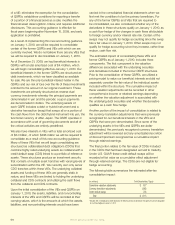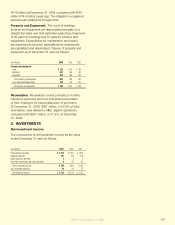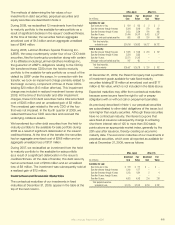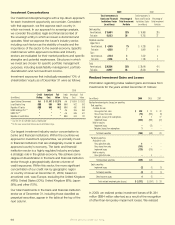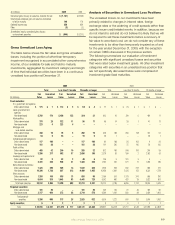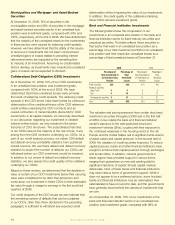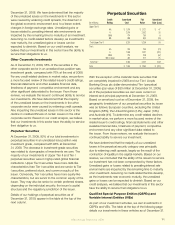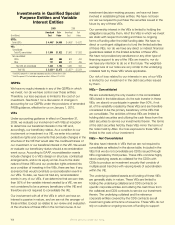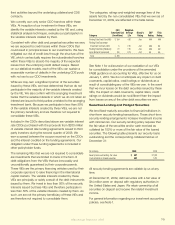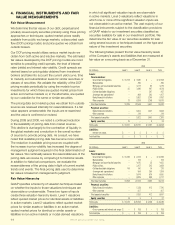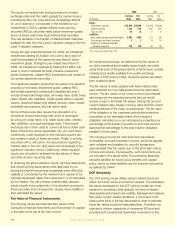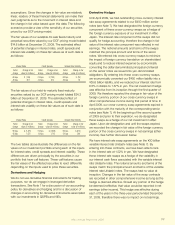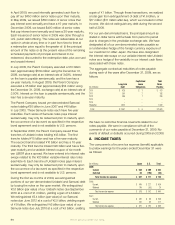Aflac 2009 Annual Report Download - page 74
Download and view the complete annual report
Please find page 74 of the 2009 Aflac annual report below. You can navigate through the pages in the report by either clicking on the pages listed below, or by using the keyword search tool below to find specific information within the annual report.
Municipalities and Mortgage- and Asset-Backed
Securities
At December 31, 2009, 74% of securities in the
municipalities sector and 39% of securities in the mortgage-
and asset-backed securities sector in an unrealized loss
position were investment grade, compared with 53% and
100%, respectively, at the end of 2008. We have determined
that the majority of the unrealized losses on the investments
in these sectors were caused by widening credit spreads.
However, we have determined that the ability of the issuers
to service our investments has not been compromised.
Unrealized gains or losses related to prevailing interest
rate environments are impacted by the remaining time
to maturity of an investment. Assuming no credit-related
factors develop, as investments near maturity the unrealized
gains or losses can be expected to diminish.
Collateralized Debt Obligation (CDO) Investments
As of December 31, 2009, 12% of our CDO investments
in an unrealized loss position was investment grade,
compared with 100% at the end of 2008. We have
determined that these unrealized losses were primarily
the result of widening credit spreads. The widening credit
spreads in the CDO sector have been fueled by continued
deterioration of the creditworthiness of the CDS reference
credit entities underlying the CDO contracts and an
overall contraction of market liquidity (demand) for CDO
investments in all capital markets. As more fully described
in our discussion regarding our investment in variable
interest entities below, we only invested in the senior
tranches of CDO structures. The subordinated tranches
of our CDOs absorb the majority of the risk of loss, if any,
arising from the CDS contracts underlying our CDOs. As a
part of our credit analysis process, we obtain CDS default
and default recovery probability statistics from published
market sources. We use these default and default recovery
statistics to project the number of defaults our CDOs can
withstand before our CDO investment would be impaired.
In addition to our review of default and default recovery
statistics, we also assess the credit quality of the collateral
underlying our CDOs.
Based on these reviews, we determined that the declines in
value of certain of our CDO investments below their carrying
value were considered to be other than temporary and
wrote down our investment in these CDOs to their estimated
fair value through a charge to earnings in the rst and third
quarters of 2009.
Our credit analyses of the CDO issues we own indicate that
the remaining number of defaults that can be sustained
in our CDOs, other than those disclosed in the preceding
paragraph, is sufcient to withstand any expected credit
deterioration without impairing the value of our investments.
In addition, the credit quality of the collateral underlying
these CDOs remains investment grade.
Bank and Financial Institution Investments
The following table shows the composition of our
investments in an unrealized loss position in the bank and
nancial institution sector by xed-maturity securities and
perpetual securities. The table reects those securities in
that sector that were in an unrealized loss position as a
percentage of our total investment portfolio in an unrealized
loss position and their respective unrealized losses as a
percentage of total unrealized losses at December 31.
2009 2008
Percentage of Percentage of Percentage of Percentage of
Total Investments in Total Total Investments in Total
an Unrealized Loss Unrealized an Unrealized Loss Unrealized
Position Losses Position Losses
Fixed maturities 33% 44% 41% 40%
Perpetual securities:
Upper Tier II 5 5 9 8
Tier I 4 10 6 12
Total perpetual securities 9 15 15 20
Total 42% 59% 56% 60%
The valuation and pricing pressures from certain structured
investment securities throughout 2008 and in the rst half
of 2009, more notably the bank and nancial institution
sector’s exposure to the well-publicized structured
investment vehicles (SIVs), coupled with their exposure to
the continued weakness in the housing sector in the UK,
Europe and the United States, led to signicant write-downs
of asset values and capital pressure. In the second half of
2009, the valuation of credit securities improved. To reduce
capital pressure, banks and other nancial institutions have
sought to enhance their capital positions through exchanges
and tender offers. In addition, national governments in
these regions have provided support in various forms,
ranging from guarantees on new and existing debt to
signicant injections of capital. Should capital markets
deteriorate, more of these banks and nancial institutions
may need various forms of government support. While it
does not appear to be a preferred solution, some troubled
banks and nancial institutions may be nationalized. Few
nationalizations have occurred to date, and the governments
have generally stood behind the classes of investments that
we own.
As of December 31, 2009, 75% of our investments in the
bank and nancial institution sector in an unrealized loss
position was investment grade, compared with 96% at
We’ve got you under our wing.
70


